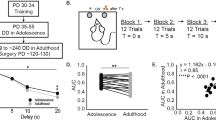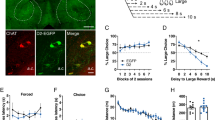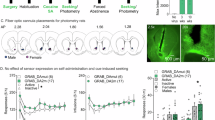Abstract
Previous research has identified the nucleus accumbens (NAcb) as an important brain region underlying inter-individual variation in impulsive behavior. Such variation has been linked to decreased dopamine (DA) D2/3 receptor availability in the ventral striatum of rats exhibiting spontaneously high levels of impulsivity on a 5-choice serial reaction time (5-CSRT) test of sustained visual attention. This study investigated the involvement of DA D2/3 receptors in the NAcb core (NAcbC) and the NAcb shell (NAcbS) in impulsivity. We investigated the effects of a DA D2/3 receptor antagonist (nafadotride) and a DA D2/3 partial agonist (aripiprazole) infused directly into either the NAcbC or NAcbS of rats selected for high (HI) and low (LI) impulsivity on the 5-CSRT task. Nafadotride increased significantly the level of impulsivity when infused into the NAcbS, but decreased impulsivity when infused into the NAcbC of HI rats. By contrast, intra-NAcb microinfusions of aripiprazole did not affect impulsivity. Systemic administration of nafadotride had no effect on impulsive behavior but increased the number of omissions and correct response latencies, whereas systemic injections of aripiprazole decreased impulsive and perseverative behavior, and increased the number of omissions and correct response latencies. These findings indicate an opponent modulation of impulsive behavior by DA D2/3 receptors in the NAcbS and NAcbC. Such divergent roles may have relevance for the etiology and treatment of clinical disorders of behavioral control, including attention-deficit hyperactivity disorder and drug addiction.
Similar content being viewed by others

Log in or create a free account to read this content
Gain free access to this article, as well as selected content from this journal and more on nature.com
or
References
Aron AR, Durston S, Eagle DM, Logan GD, Stinear CM, Stuphorn V (2007). Converging evidence for a fronto-basal-ganglia network for inhibitory control of action and cognition. J Neurosci 27: 11860–11864.
Bari A, Dalley JW, Robbins TW (2008). The application of the 5-choice serial reaction time task for the assessment of visual attentional processes and impulse control in rats. Nat Protoc 3: 759–767.
Barik A, de Beaurepaire R (2005). Dopamine D3 modulation of locomotor activity and sleep in the nucleus accumbens and in lobules 9 and 10 of the cerebellum in the rat. Prog Neuropsychopharmacol Biol Psychiatry 29: 718–726.
Belin D, Everitt BJ (2008). Cocaine seeking habits depend upon dopamine-dependent serial connectivity linking the ventral with the dorsal striatum. Neuron 57: 432–441.
Belin D, Mar AC, Dalley JW, Robbins TW, Everitt BJ (2008). High impulsivity predicts the switch to compulsive cocaine-taking. Science 320: 1352–1355.
Benoit-Marand M, Borrelli E, Gonon F (2001). Inhibition of dopamine release via presynaptic D2 receptors: time course and functional characteristics in vivo. J Neurosci 21: 9134–9141.
Boulougouris V, Castañé A, Robbins TW (2008). Dopamine D2/D3 receptor agonist quinpirole impairs spatial reversal learning in rats: investigation of D3 receptor involvement in persistent behavior. Psychopharmacology (Berl) 202: 611–620.
Brewer JA, Potenza MN (2008). The neurobiology and genetics of impulse control disorders: relationships to drug addictions. Biochem Pharmacol 75: 63–75.
Cardinal RN, Aitken MRF (2001). Whisker, version 3.0, computer software. http://www.whiskercontrol.com.
Cardinal RN, Pennicott DR, Sugathapala CL, Robbins TW, Everitt BJ (2001). Impulsive choice induced in rats by lesions of the nucleus accumbens core. Science 292: 2499–2501.
Chudasama Y, Passetti F, Rhodes SE, Lopian D, Desai A, Robbins TW (2003). Dissociable aspects of performance on the 5-choice serial reaction time task following lesions of the dorsal anterior cingulate, infralimbic and orbitofrontal cortex in the rat: differential effects on selectivity, impulsivity and compulsivity. Behav Brain Res 146: 105–119.
Cole BJ, Robbins TW (1989). Effects of 6-hydroxydopamine lesions of the nucleus accumbens septi on performance of a 5-choice serial reaction time task in rats: implications for theories of selective attention and arousal. Behav Brain Res 33: 165–179.
Dalley JW, Fryer TD, Brichard L, Robinson ES, Theobald DE, Lääne K et al (2007). Nucleus accumbens D2/3 receptors predict trait impulsivity and cocaine reinforcement. Science 315: 1267–1270.
Dalley JW, Mar AC, Economidou D, Robbins TW (2008). Neurobehavioral mechanisms of impulsivity: fronto-striatal systems and functional neurochemistry. Pharmacol Biochem Behav 90: 250–260.
DeLeon A, Patel NC, Crismon ML (2004). Aripiprazole: a comprehensive review of its pharmacology, clinical efficacy, and tolerability. Clin Ther 26: 649–666.
Diergaarde L, Pattij T, Poortvliet I, Hogenboom F, de Vries W, Schoffelmeer AN et al (2008). Impulsive choice and impulsive action predict vulnerability to distinct stages of nicotine seeking in rats. Biol Psychiatry 63: 301–308.
Eagle DM, Bari A, Robbins TW (2008). The neuropsychopharmacology of action inhibition: cross-species translation of the stop-signal and go/no-go tasks. Psychopharmacology (Berl) 199: 439–456.
Economidou D, Pelloux Y, Robbins TW, Dalley JW, Everitt BJ (2009). High impulsivity predicts relapse to cocaine-seeking after punishment-induced abstinence. Biol Psychiatry 65: 851–856.
Floresco SB (2007). Dopaminergic modulation of limbic-striatal interplay. J Psychiatry Neurosci 32: 400–411.
Griffon N, Sokoloff P, Diaz J, Lévesque D, Sautel F, Schwartz JC et al (1995). The dopamine D3 receptor and schizophrenia: pharmacological, anatomical and genetic approaches. Eur Neuropsychopharmacol 5: 3–9.
Goto Y, Grace AA (2005). Dopaminergic modulation of limbic and cortical drive of nucleus accumbens in goal-directed behavior. Nat Neurosci 8: 805–812.
Groenewegen HJ, Wright CI, Beijer AV, Voorn P (1999). Convergence and segregation of ventral striatal inputs and outputs. Ann N Y Acad Sci 877: 49–63.
Haber SN, Fudge JL, McFarland NR (2000). Striatonigrostriatal pathways in primates form an ascending spiral from the shell to the dorsolateral striatum. J Neurosci 20: 2369–2382.
Ikemoto S (2007). Dopamine reward circuitry: two projection systems from the ventral midbrain to the nucleus accumbens-olfactory tubercle complex. Brain Res Rev 56: 27–78.
Ito R, Robbins TW, Everitt BJ (2004). Differential control over cocaine-seeking behavior by nucleus accumbens core and shell. Nat Neurosci 7: 389–397.
Levant B (1997). The D3 dopamine receptor: neurobiology and potential clinical relevance. Pharmacol Rev 49: 231–252.
Levant B, Vansell NR (1997). In vivo occupancy of D2 dopamine receptors by nafadotride. Neuropsychopharmacology 17: 67–71.
Mameli M, Halbout B, Creton C, Engblom D, Parkitna JR, Spanagel R et al (2009). Cocaine-evoked synaptic plasticity: persistence in the VTA triggers adaptations in the Nac. Nature Neurosci 12: 1036–1041.
Mogenson GJ, Jones DL, Yim CY (1980). From motivation to action: functional interface between the limbic system and the motor system. Prog Neurobiol 14: 69–97.
Muir JL, Everitt BJ, Robbins TW (1996). The cerebral cortex of the rat and visual attentional function: Dissociable effects of mediofrontal, cingulate, anterior dorsolateral, and parietal cortex lesions on a five-choice serial reaction time task. Cerebral Cortex 6: 470–481.
Murphy ER, Robinson ES, Theobald DE, Dalley JW, Robbins TW (2008). Contrasting effects of selective lesions of nucleus accumbens core or shell on inhibitory control and amphetamine-induced impulsive behaviour. Eur J Neurosci 28: 353–363.
Nader MA, Morgan D, Gage HD, Nader SH, Calhoun TL, Buchheimer N et al (2006). PET imaging of dopamine D2 receptors during chronic cocaine self-administration in monkeys. Nat Neurosci 9: 1050–1056.
Nordquist RE, Risterucci C, Moreau JL, von Kienlin M, Künnecke B, Maco M et al (2008). Effects of aripiprazole/OPC-14597 on motor activity, pharmacological models of psychosis, and brain activity in rats. Neuropharmacology 54: 405–416.
Pattij T, Janssen MC, Vanderschuren LJ, Schoffelmeer AN, van Gaalen MM (2007). Involvement of dopamine D1 and D2 receptors in the nucleus accumbens core and shell in inhibitory response control. Psychopharmacology (Berl) 191: 587–598.
Pattij T, Vanderschuren LJ (2008). The neuropharmacology of impulsive behaviour. Trends Pharmacol Sci 29: 192–199.
Paxinos G, Watson C (1998). The Rat Brain in Stereotaxic Coordinates. Academic Press: Orlando, FL.
Pezze MA, Dalley JW, Robbins TW (2009). Remediation of attentional dysfunction in rats with lesions of the medial prefrontal cortex by intra-accumbens administration of the dopamine D(2/3) receptor antagonist sulpiride. Psychopharmacology (Berl) 202: 307–313.
Pilla M, Perachon S, Sautel F, Garrido F, Mann A, Wermuth CG et al (1999). Selective inhibition of cocaine-seeking behaviour by a partial dopamine D3 receptor agonist. Nature 400: 371–375.
Robbins TW, Everitt BJ (1996). Neurobehavioural mechanisms of reward and motivation. Curr Opin Neurobiol 6: 228–236.
Robinson ES, Eagle DM, Economidou D, Theobald DE, Mar AC, Murphy ER et al (2009). Behavioural characterisation of high impulsivity on the 5-choice serial reaction time task: specific deficits in ‘waiting’ vs ‘stopping’. Behav Brain Res 196: 310–316.
Rogers RD, Baunez C, Everitt BJ, Robbins TW (2001). Lesions of the medial and lateral striatum in the rat produce differential deficits in attentional performance. Behav Neurosci 115: 799–811.
Sautel F, Griffon N, Sokoloff P, Schwartz JC, Launay C, Simon P et al (1995). Nafadotride, a potent preferential dopamine D3 receptor antagonist, activates locomotion in rodents. J Pharmacol Exp Ther 275: 1239–1246.
Sesia T, Temel Y, Lim LW, Blokland A, Steinbusch HW, Visser-Vandewalle V (2008). Deep brain stimulation of the nucleus accumbens core and shell: Opposite effects on impulsive action. Exp Neurol 214: 135–139.
Solanto MV (2002). Dopamine dysfunction in AD/HD: integrating clinical and basic neuroscience research. Behav Brain Res 130: 65–71.
St Onge JR, Floresco SB (2009). Dopaminergic modulation of risk-based decision making. Neuropsychopharmacology 34: 681–697.
Vallone D, Picetti R, Borrelli E (2000). Structure and function of dopamine receptors. Neurosci Biobehav Rev 24: 125–132.
Viggiano D, Ruocco LA, Sadile AG (2003). Dopamine phenotype and behaviour in animal models: in relation to attention deficit hyperactivity disorder. Neurosci Biobehav Rev 27: 623–637.
Weiner I, Gal G, Feldon J (1999). Disrupted and undisruptable latent inhibition following shell and core lesions. Ann N Y Acad Sci 877: 723–727.
Winstanley CA, Eagle DM, Robbins TW (2006). Behavioral models of impulsivity in relation to ADHD: translation between clinical and preclinical studies. Clin Psychol Rev 26: 379–395.
Volkow ND, Fowler JS, Wang GJ, Baler R, Telang F (2009). Imaging dopamine's role in drug abuse and addiction. Neuropharmacology 56: 3–8.
Yang CR, Mogenson GJ (1986). Dopamine enhances terminal excitability of hippocampal-accumbens neurons via D2 receptor: role of dopamine in presynaptic inhibition. J Neurosci 6: 2470–2478.
Zahm DS (1999). Functional-anatomical implications of the nucleus accumbens core and shell subterritories. Ann N Y Acad Sci 877: 113–128.
Zahm DS (2000). An integrative neuroanatomical perspective on some subcortical substrates of adaptive responding with emphasis on the nucleus accumbens. Neurosci Biobehav Rev 24: 85–105.
Acknowledgements
This study was funded by the Wellcome Trust (076274/2/04/2), MRC (G0600196, G0401068), IMAGEN under the European Communities Sixth Framework Programme (LSHM-CT-2007-037286), and the National Institute on Drug Abuse (Intramural Research Program). MB was supported by a ‘Fondation pour la Recherche Médicale’ fellowship. The authors thank Alan G Lyon for technical assistance.
Author information
Authors and Affiliations
Corresponding author
Additional information
DISCLOSURE
TWR discloses consultancy for Cambridge Cognition, Pfizer, E Lilly Inc., Wyeth, GlaxoSmithKline, and Roche and holds share options in Cambridge Cognition and Allon Therapeutics. MB, DB, RM, DT, AC, VB, BC, AN, BE, and JD have no disclosures.
Supplementary Information accompanies the paper on the Neuropsychopharmacology website (http://www.nature.com/npp)
Rights and permissions
About this article
Cite this article
Besson, M., Belin, D., McNamara, R. et al. Dissociable Control of Impulsivity in Rats by Dopamine D2/3 Receptors in the Core and Shell Subregions of the Nucleus Accumbens. Neuropsychopharmacol 35, 560–569 (2010). https://doi.org/10.1038/npp.2009.162
Received:
Revised:
Accepted:
Published:
Issue date:
DOI: https://doi.org/10.1038/npp.2009.162
Keywords
This article is cited by
-
Inhibition of ventral tegmental area projections to the nucleus accumbens shell increases premature responding in the five-choice serial reaction time task in rats
Brain Structure and Function (2023)
-
Assessing attention and impulsivity in the variable stimulus duration and variable intertrial interval rodent continuous performance test schedules using dopamine receptor antagonists in female C57BL/6JRj mice
Psychopharmacology (2023)
-
Risky decision-making predicts dopamine release dynamics in nucleus accumbens shell
Neuropsychopharmacology (2020)
-
Dorsal and ventral striatal dopamine D1 and D2 receptors differentially modulate distinct phases of serial visual reversal learning
Neuropsychopharmacology (2020)
-
Top-down control of the medial orbitofrontal cortex to nucleus accumbens core pathway in decisional impulsivity
Brain Structure and Function (2019)


